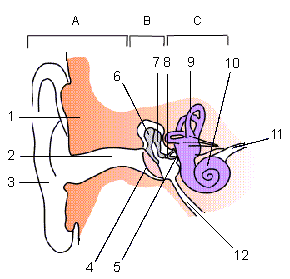


Similar term(s): ear canal, auditory canal, eardrum, outer ear, inner ear, middle ear, cochlea, cochlear, vestibule.
The ear consists of the outer, middle, and inner ear. It plays a role in hearing, balance, and spatial orientation.
The outer ear collects sound. It includes the auricle, the auditory canal, and the external surface of the eardrum, which is a membrane separating the outer and middle ear.
The middle ear is the cavity behind the eardrum. In response to sound waves, the eardrum vibrates. The vibration is passed on to small bones (hammer, anvil, and stirrup) that amplify and transmit the vibrations to the inner ear.
The inner ear includes the vestibule and the cochlea. The vestibule is the organ that contributes to balance and spatial orientation. The cochlea is the hearing organ. It contains specialised sensory cells called hair cells. When the “hairs” are moved as a result of sound vibrations, these cells translate this mechanical stimulation into an electrical signal that is carried to the brain by the auditory nerve.
Source: GreenFacts, based on the National Institute for Health
Glossary ![]()

Source:
Free Software Foundation![]()
GreenFacts Summary on Personal Music Players & Hearing
Deutsch: Ohr
Español: Oído
Français: Oreille